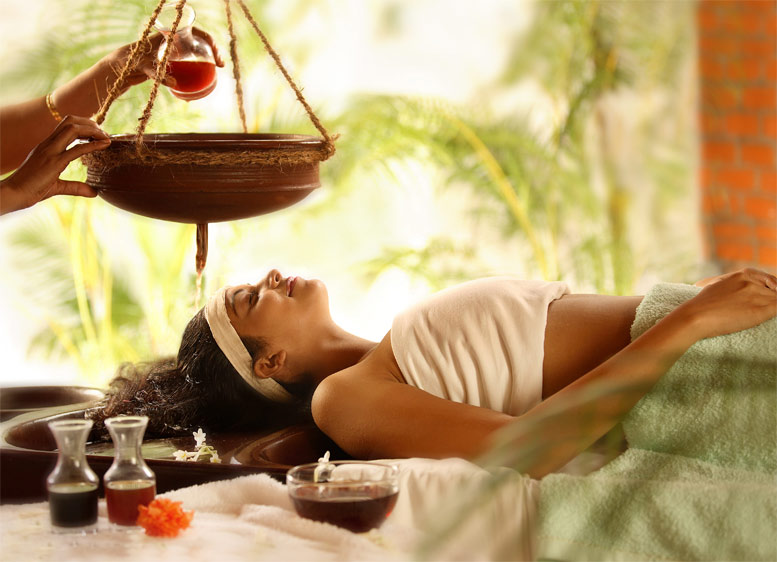Panchakarma
Panchakarma Treatment

Introduction
Panchakarma Process
Panchakarma technique includes five major procedures which help to purify the whole body by eliminating the accumulated toxins. This process includes treatments like Virechana (Purgation), Vamana (Emesis), Snehavasthi (Medicated Oil Enema), Kashayavasti (Medicated Decoction Enema) & Nasya (Nasal Administration). The specialty of this treatment is that it can be administered both in a healthy as well as a person with diseases. When a healthy person subjects himself to Panchakarma, it has a preventive, restorative and rejuvenative effect on the body.
Nasya
Nasya is one among the five major processes in Ayurveda. It is a therapeutic process in which herbal medicines are administered through nostrils. The nose is the doorway to our brain and consciousness. This therapy cleanses and opens the channels of the head, thereby improving the process of oxygenation which has a direct influence on the functioning of brain. NASYA is used for patients with the disease of head, neck and shoulders. Imbalance of body humers (dosa imbalance) can be balanced by nasya; especially kapha type imbalances. It can be used both as preventive and curative aspect.
Nasya strengthens the eyes, ears and nose. It helps and eliminates the accumulated toxins in the head region. Nasya treatment is highly effective for head ache, migraine, frozen shoulder, hair fall, facial palsy, etc. We have to prepare our body for nasya therapy which is called poorva karma or pre therapeutic measures. It includes (1) Snehana which is an application of slightly warm oil on shoulder, neck and face and Swedana in which formentation is given from medicated water.
Next procedure is nasya. After nasya the patient have to follow post therapeutic measures (paschatkarma). He should rest till the slime is spitted out.,then gargle mouth with hot water and wash face with hot water. Dose, time and medicine will be selected according to the aggrevated dosa, type of body constitution, nature of ailments, strength of patient etc. There are four types of nasya viz., Eliminative nasya, Nourishing nasya, Cleansing nasya & Daily nasya which is selected according to the body nature by the ayurveda physician.
Vamana
It is a cleansing procedure or purificatory therapy in which the toxins in the body are eliminated through oral route and can balance three dosa . Detoxification through vamana is suggested in diseases which mainly involve kapha dosha.
Before inducing vamana, the toxins that are adhered or accumulated over all tissues are brought to amashaya or stomach with various preparatory methods( poorvakarma) like snehana and swedana. Snehana is lubrication therapy which helps in softening the tissues and seperates the debris from healthy tissue. Swedana is sweat therapy liquefying the debris entangled in tiny channels when the toxins are seperated and liquefied.
It is easy to get collected in stomach with the help of herbal medication. Then vamana karma is performed after a sequence of procedures under the supervision of a panchakarma expert. It is a whole body purification therapy also indicated in ailments like psoriasis, obesity, asthma, skin disease, cough etc. After vamana karma the patient should be taken care with post therapeutic procedure (paschat karma )like smoke treatment,herbal diet, rest , hot water bath etc.
Patient is gradually rehabilitated to regular diet and lifestyle. Whether the person is fit for this procedure or not is decided by the physician. Number of days needed for this karma depends on strength of ailments or rate of imbalance of dosas.
Vasti
Vasti is one of the major panchakarma treatments. In this therapy, medicine is administered through anal route and toxins are eliminated through anus. This helps in balancing thri dosa and detoxify body tissues. This procedure is mainly done for vata disorders. Vata is a powerful dosa among the three dosas. So this technique is important among the five karmas.
Vasti is basically of two types; Niruha vasti that uses medicated decoction and other is Anuvasana vasti which is done with medicated oil. Like other therapies, even vasti has pretherapeutic and post therapeutic technique. Pretherapeutic technique includes snehana lubrication internally and externally and also swedana, a sweat therapy. These poorvakarma helps in loosening and liquefying the toxins accumulated in cells and gets collected in colon. After the application of herbal medicines these toxins collected in colon get eliminated. In curative aspect vasti is indicated for arthritis, backpain, sexual dysfunction, neuro muscular problems etc.
Diet is a very important factor and should follow the physician’s instructions very strictly. This comes in post therapeutic measures(paschatkarma). Person who has been given vasti must have a light diet for a day. He/she must also avoid sitting, standing, and talking for a long duration, travelling or sleeping during the day, coitus (sexual intercourse), exposure to cold or too much sunlight, anxiety, anger, untimely meals, an incompatible diet, and suppression of natural urges.
Virechana
Virechana is expelling the vitiated doshas and toxins through anus. This therapy can be conducted as an individual detoxification therapy or as a follow up of another therapy.
Virechana is a non painful and easiest procedure. Complications are usually very rare in this therapy. This detoxification method helps to expel toxins and vitiated doshas from blood, liver and intestines. It purifies blood and skin. This process cleans up the gastro intestinal tract. Usual panchakarma preparatory methods(poorvakarma) like snehana and swedana are completed before inducing purgation. Virechana is induced by administering herbal purgatives, when pitta dosha is dominant.
Patient is made to drink warm water repeatedly as he passes stools. Patient is later rehabilitated to special diet and lifestyle(paschat karma). This therapy is suggested for disorders in which pitta is the prominent dosha. Skin diseases, jaundice, constipation, headache, fistula, hemorrhoids, intestinal parasites, herpes, anemia, edema, etc. are a few of the many diseases in which Virechana is chosen as a detoxifying therapy.
